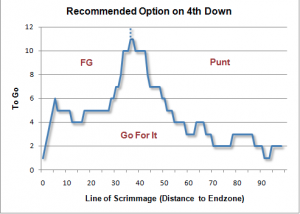American Football: What to do at Crunch Time?
Sports are some of the worlds most popular games played and American football is one of the most followed. Every down played in football is planned beforehand; the formula of each play is decided upon by coaches and players from carefully designed and endlessly practiced strategies. Both offense and defense have multiple plays to choose from for a given situation. One situation worthy of critical analyzation is that of the fourth down. The fourth down marks the end of a teams possession, the rebirth of a teams possession, or the scoring of points, should a field goal be made. Game theory can be used to aid football teams and help them decide what is the best plan of action on fourth down.
Brian Burke, on November 12, 2014, posted an article entitled “4th Down Study” to advancedfootballanalytics.com. In this article, Burke uses a simple expected outcome algorithm and gathered data showing success rates of fourth down strategies under given circumstances. The primary circumstances he analyzes are distances from either the end zone or the first down marker. After calculating dominant strategies for given distances, Burke creates a graph marking what a teams plan of attack should be on fourth down given their current yardage from the end zone and the first down marker. The three strategies are to attempt a field goal, to go for the first down, or to punt the ball farther down field to create a greater disadvantage to the opposing team. Burke summarizes these outcomes of his data in the following graph:
Some general trends to take note of are that any time a team is within 1 yard and very often 2 yards of a first down, the team should go for a first down. Also generally, if a team is greater than six yards from the first down, they should either attempt a field goal or punt depending on their distance from the end zone. Something very interesting is that when the team is around 40 yards from the end zone; The team should always go for the first down even when up to 11 yards from the first down marker which is often against what most people think. The reason for this phenomena is that at around 40 yards, the percentage of making a field goal drops to below 50% and the expected points that the other team can achieve drops below 3 which is the minimum a team can make on an offensive drive. Based on this data, yes, it is the dominant strategy to “go for it” on fourth down when you are around the 40 yard line. Burke concludes his article by asking the following question: “If the benefit of going for it is so clear, why are coaches choosing to kick so often?”. The actual trend in football goes against his data and Burke is wondering why. He provides two explanations. First is that punting often ensures that the opposing team wont score on their next possession and second, he takes from a man named David Romer who “suggests that coaches are thinking more about their job security than their team’s chances of winning”. In the end, Burke has used the concept of game theory and dominant strategies to predict how teams should behave when it comes to fourth down situations and hopes one day teams will follow his model, “What I hope is that some coaches will one day see research like this and reset their baseline 4th down paradigm”.
Using what we have learned in class, game theory and dominant strategies are the primary focus of this analysis. Burke used his accumulated data to produce a dominant strategy for any given offensive situation by position. There is only one player in our game, the offensive team, and there are three strategies the team can choose from: punting, going for a first down, or attempting a field goal. Each yardage situation has its own game scenario with certain payoffs. and in each game, Burke found one dominant strategy. When the team is very close to the end zone but is around 5 or 6 yards from a first down, the team should kick a field goal because they have a higher probability of earning points than the probability of them earning a first down. Thus their payoff is higher if they were to kick a field goal in those scenarios. Similarly we can use the graph to find the dominant strategy and the higher payoff at any other scenario, whether it be punting, kicking a field goal, or going for a first down. Assuming this data is accurate, and using game theory to find these dominant strategies, teams should most definitely follow suit and adopt this model for deciding fourth down strategies in game as it should theoretically result in a higher rate of success.
Source:http://www.advancedfootballanalytics.com/index.php/home/research/game-strategy/120-4th-down-study

